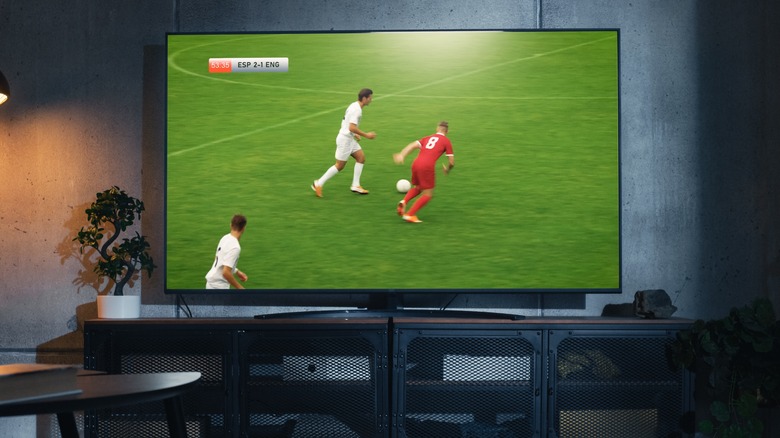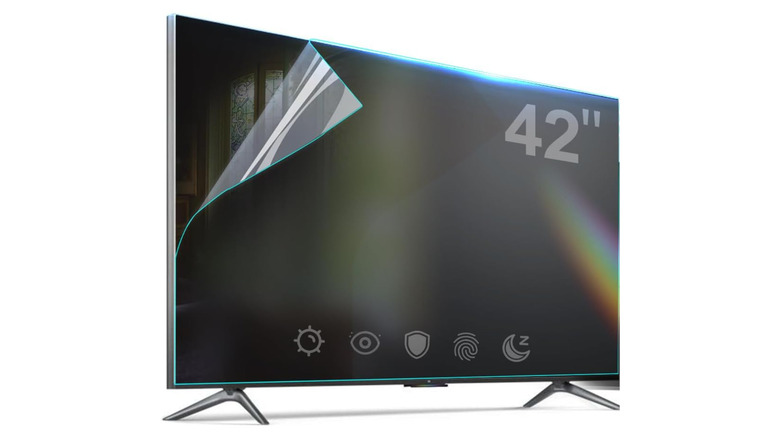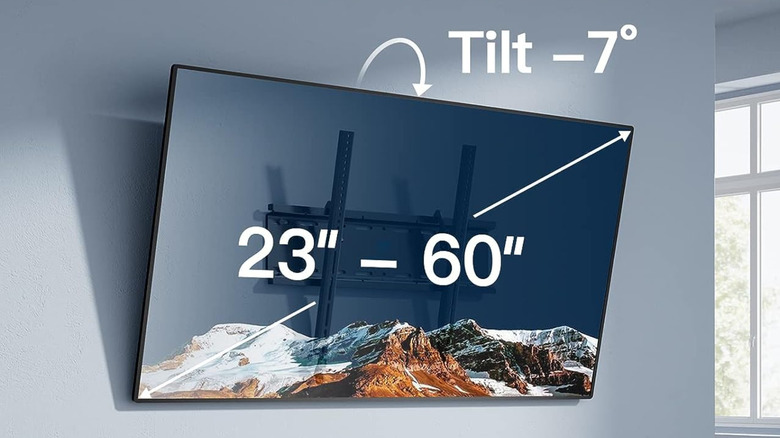7 Ways To Reduce The Glare On Your TV Screen
We may receive a commission on purchases made from links.
Even though television sets have evolved from huge boxes to flat screens, there's one thing that still comes in the way of the perfect viewing experience: Glare. No matter what the source is — a bulb, lamp, or window — a glossy TV screen acts like a mirror, and its reflection shows as a bright spot on the television screen. This not only reduces the overall immersion but also ruins the viewing experience, however expensive the television is.
While most TV screens feature a glossy finish, a few models ship with matte panels designed to minimize on-screen reflections. However, a matte screen, whether on a television, a tablet, or a smartphone, diffuses not only the light that shines on it but also the light that comes from underneath, resulting in a screen that looks dull. So, is there a way to reduce the glare on your TV screen without compromising on the picture quality?
Yes, there are multiple ways to get rid of the irritating reflections that stand between you and your favorite movies or TV shows. We'll start with the easiest workarounds that won't cost you anything and then gradually move toward the methods that are slightly more time-consuming and might require some monetary attention.
Dim the lights in your room or adjust your TV's brightness
The first and easiest method is to dim the lights in your room. This tried-and-true method allows the screen to deliver its best in terms of brightness and colors, as there's no secondary light source that could glare at you through the TV screen. However, we don't recommend it for an extended duration, as it could put excessive strain on your eyes.
If you absolutely have to watch the screen without turning on the lights, consider dimming its brightness a bit. If possible, place a relatively dimmer light source, like a lamp or an LED strip, behind your TV screen, as it increases the ambient light in the room without obstructing your vision (directly or indirectly). To get the best results, spend some time looking for color-neutral lights, as they don't degrade your TV's color reproduction.
On the other hand, if your television sits in a bright room with a lot of lights, consider increasing your TV's brightness. Simply go to the picture settings on your TV and tweak the brightness and contrast settings. The goal here isn't to set the brightness at maximum; it is to find the sweet spot that provides an optimum viewing experience based on the ambient lighting. You can also experiment with the built-in picture modes, such as vivid, natural, sports, and cinema, which automatically adjust the brightness and contrast to the pre-determined values.
Block the sunlight with curtains or get an anti-glare film
If your room gets too bright with natural light, consider putting curtains on the windows, especially if you (or any other family member) watch the TV during the day. Since darker colors absorb more light, getting black or dark gray ones will be more effective. Even though regular curtains can remedy the situation to an extent, they might allow some light to pass through. Hence, to create a theater-like environment by blocking more light, consider getting a pair of blackout curtains on windows that get direct sunlight. Generally, blackout curtains are made of a thicker and heavier fabric than the regular ones, which is also why they could cost a tad more. Depending on the window size, blackout curtains can cost you about $20 to $50 for a pair.
You can also purchase an anti-glare TV film that reduces the visual distraction caused by glares. Usually, these films consist of multiple layers that scatter the light in different directions, reducing the glare on your TV screen. However, there are two potential downsides to using an anti-glare film. First, it is hard to apply self-adhesive films on larger screens, and second, the film could degrade your TV's picture quality ever so slightly. To get the best results, you can adjust your TV's brightness and contrast (increase them a bit) after applying the anti-glare film. Generally, good quality anti-glare films cost around $100, depending on the size of your TV.
Get a tilt mount for your TV or rearrange the lights in your room
The glare on your TV screen comes from light that reflects off its surface (at a certain angle) and directly shines toward you. But what if we could change the angle without changing the light? Well, that's what a tilt mount does. A tilt mount lets you change the angle and position of your TV screen relative to the light source, which, in turn, reduces the glare. Based on the angle you're watching your TV, tilting it upward, downward, or moving it toward the side can do the trick. Of course, this method involves purchasing a new mount and getting it drilled into your wall, so it could cost you a few hundred dollars. If you're concerned about the unruly wires, check out our article on ways to hide them from a mounted TV.
If remounting the television isn't an option, your only choice is to remedy the room's lights. Using a lot of fancy lights, such as light stands, table lamps, focus lights, etc., can cause glare on your TV screen. Consider arranging them in a manner that the TV isn't directly in the path of a light source. Alternatively, you can reduce the intensity of your room's light by applying frosted shades, ceiling diffusers, a dark film, or smaller curtains; all these items are readily available online or at a hardware store.
If essential, invest in a new mini-LED or OLED TV
Finally, the hardest and most expensive way to get rid of glare is to get a new TV. Generally, TVs with mini-LED or OLED panels have a higher brightness level, which can make the reflections less apparent. Usually, a good quality mini-LED or OLED TV can set you back over $1,000, depending on the panel technology, brand, and screen size you choose. The second thing you should consider is whether your TV has an anti-reflective display. In 2023, Samsung released its QD-OLED series with an anti-reflective coating that improves the screen's visibility. Now, the latest Samsung OLED TVs come with a screen that is so advanced that it removes the shape of reflections, making the glare much less evident.
Before you go ahead and purchase the desired model, consider spending some time planning its placement, as it could either make or break your family time. Start by observing the natural inflow of light in your house, specifically the room you're getting the TV for. Choose a wall that receives minimum sunlight, especially during your viewing hours. Further, the screen should be placed at the right height to avoid any reflections from the lights in the room.




